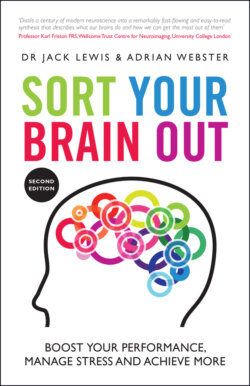Читать книгу Sort Your Brain Out - Джек Льюис, Адриан Вебстер - Страница 36
Brain training ourselves to distraction?
ОглавлениеOne early study found that people who regularly used different types of technology all at the same time (heavy media multitaskers) were less able to block out distractions in a simple visual task than those tended to only use one form of media at a time (low media multitaskers). The performance of the heavy media multitaskers declined more and more when extra distractors were added around the targets, while that of the low media multitaskers remained steady no matter how many distractors were added. In other words, the low media multitaskers had retained their ability to ignore the distractors but the heavy multitaskers seem to have lost this basic ability.
A likely explanation for this is that their daily, intensive, long‐term media multitasking habits may have led to brain changes that made them more easily distracted. They may have unwittingly trained their brain to constantly refocus on any extra information in the scene, regardless of its relevance to the task at hand. The only way to prove that these behaviours actually cause increased sensitivity to distraction would be to compare measurements before and after people started engaging in heavy multitasking. The trouble is such people are almost impossible to find. In the meantime, you might want to think twice the next time you start checking your phone, while watching the news on TV, during a videoconference attended via your laptop.
Heavy media multitaskers are generally worse at controlling their impulses and score lower in tests of fluid intelligence than low media multitaskers.
One thing that should be becoming crystal clear by now is the need to stop and think. In using all the wonderful tools of digital technology, how much is too much if we want to avoid sleepwalking into a nightmare of attention problems and undernourished empathy circuits? We need to dream up ways to gain all the benefits, but without falling into the trap of accidentally adopting habits that actually work against our best interests. Trying to establish our own personal set of rules governing how we actually use each type of technology is a good place to start. For instance, next time you get a new phone, actually read the instruction manual, or the help webpages. Not the whole thing, just the part that guides you through the process of changing which alerts can make it buzz and bleep and which silently register the messages without causing endless “unintentional” distractions. The best approach is to switch off any alerts that are not likely to be time critical and stick the whole thing in a drawer out of sight as much as possible.
Ask yourself: do your text messages really require instant attention? Do you really have to be alerted to every single email that lands in your inbox the second it arrives? Is the news that a random stranger is now following you on Twitter, Instagram or TikTok urgent enough to risk halting a fascinating conversation, to steal precious time spent with family and friends, to derail a productive flow of thought, crash a car or walk out into the road without looking? Or can these relatively low‐priority interruptions wait until later?
